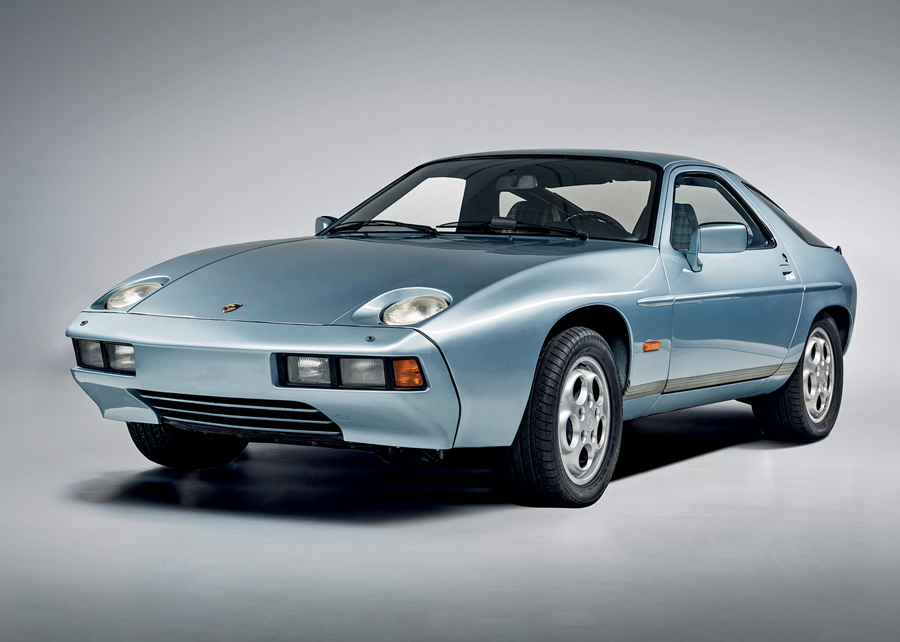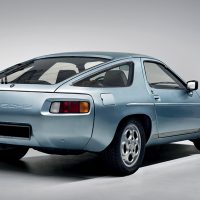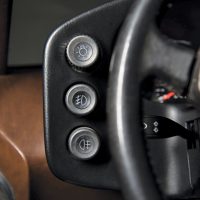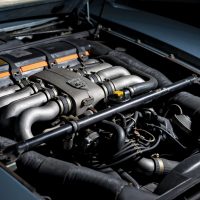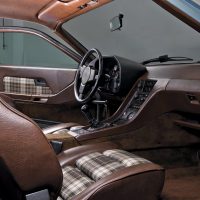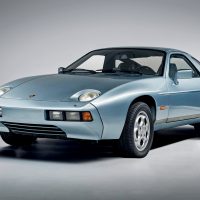SCM Analysis
Detailing
| Vehicle: | 1978 Porsche 928 Coupe |
| Years Produced: | 1977–95 |
| Number Produced: | 17,669 Gen One cars. 61,056 total for all models/all years |
| Original List Price: | $28,500 in 1978 |
| SCM Valuation: | $16,500 |
| Tune Up Cost: | $1,600 with valve adjustment — but no belts |
| Chassis Number Location: | On inner passenger’s side fender lip under hood |
| Engine Number Location: | On small boss top front right of engine |
| Club Info: | Porsche Club of America |
| Website: | http://www.pca.org |
| Alternatives: | 1978–83 Porsche 911SC, 1977–79 Ferrari 308 GTS, 1978–80 Mercedes-Benz 450SLC |
| Investment Grade: | C |
This car, Lot 147, sold for $50,798, including buyer’s premium, at Bonhams’ Zoute, Belgium, auction on October 11, 2019.
By the early 1970s, Porsche engineers had been through a wringer to get their cars “clean” enough to pass the United States’ new emissions laws.
First they had to forsake carburetors, messing up their U.S. lineup in 1968 (no 911S) while they readied mechanical fuel injection. They were in the process of moving past multiport fuel injection to continuous fuel injection, which came with the 1974 models. New U.S. crash standards were scheduled for that same year. And Naderism still threatened rear-engine cars.
Understandably, Porsche feared that increasingly strenuous laws would ultimately outlaw the 911. And, of course, the design was aging. A new car was needed.
Enter the 928 — but the 911 lived on
The 928 was the pet project of Porsche’s first non-family-member CEO, Ernst Fuhrmann, an engineer best known for designing Porsche’s 1954–65 high-performance 4-cam, 4-cylinder engines.
The 928 design was “modern,” but it turned out to be more of a grand tourer than a pur sang sports car. It was more Mercedes 450SL or BMW 6-series than 911. When it was introduced in 1977, 911 owners whispered “Nice German Thunderbird” and stayed away in droves. Ferry Porsche didn’t appreciate the car either. Then the car did not sell particularly well — never more than 5,600 units in a year.
In the end, the bigger and heavier 928 cost Fuhrmann his job.
In the early 1980s, his successor, American Peter Schutz, together with engineering chief Helmuth Bott, famously determined they would continue to develop the 911. That decision worked out well, as we look back almost 40 years later.
A sophisticated design
However, the 928 turned out to be a terrific automobile — even if not a 911.
At introduction, it featured a front-mounted, water-cooled, aluminum 4.5-liter V8 with dual overhead camshafts and fuel injection with 237 to 240 horsepower (choked down to 219 by emissions gear in the U.S.) pushing through an alloy rear transaxle with either a 5-speed stick shift or a (Mercedes-supplied) 3-speed automatic.
The 928 handled well with its sophisticated and capable suspension that incorporated Porsche’s first power steering unit — even though the car was relatively heavy at 3,200 pounds. The body design was avant-garde, with increased interior space wrapped in attractive aero-efficient bodywork that featured aluminum front fenders, hood, and doors.
The bumpers were fiberglass/polyurethane and integrated into the bodywork — a new look for Porsche.
Car of the Year
When it was introduced in January 1977 as a 1978 model, the 928 won a warm reception from the general public and the motoring press. It was powerful, very roadable, comfortable — speed with grace and aplomb.
Road testers praised the car. Writing in Porsche Panorama in April 1978, Bob Rassa concluded: “The 928 is the ultimate combination of superb styling, the quintessence of luxury, and the pinnacle of handling and performance…. It is predictable, beautiful, deliberate, and desirable — without a doubt the finest car we have ever driven.”
It all culminated when the 928 became the first-ever sports car to be voted Europe’s Car of the Year.
The 928 lasted 18 years
Porsche continually developed the 928.
During the early 1980s, they added the S model with a bigger 4.7-liter engine with 297 to 300 horsepower (234 in the U.S.) and a rear spoiler.
Mid-1983 saw the introduction of a new, Mercedes-supplied 4-speed automatic. Then Bosch ABS was added.
For the 1987 model, changes included larger displacement — up to 5 liters with 316 horsepower — camshafts doubled to four with four valves per cylinder, upgraded stick shift, and more-modern seats. The model was dubbed S32 (the number of valves) as introduced, but it was soon renamed the S4 (number of camshafts).
Today, the 928 S4 is a collector and driver sweet spot.
In 1989 Porsche launched the 928 GT with 330 horsepower. The car also had a 40% — and then variable 0–100% — limited-slip differential as standard equipment, along with airbags and a tire-pressure monitoring system.
That evolved into the GTS in 1993–94 with a longer stroke at 5.4 liters, delivering 345 horsepower, 369 ft-lb of torque, with 17-inch Cup wheels with 7.5-inch front and nine-inch rear tires under two-inch flared rear bodywork. Performance was best ever for a 928: 0–60 mph in 5.3 seconds, 170 mph top speed, and braking from 70 mph to 0 in 160 feet.
The GTS, especially with a 5-speed stick shift, is the holy grail of 928s, with prices now regularly up to $150,000. (See the German Profile, SCM June 2016, pages 74–75.)
Early 928s as collectibles?
The earliest 928s are the fourth-tier collectible in the model range, behind GTSs, GTs, and S4s. But they offer some interesting attributes.
The early cars have the original, very smooth look — before semi-air-dam bumpers, rear wings, side skirts or big wheels and flares. They often came with checkerboard, pin-striped, or plaid cloth inserts for seats and door panels, a period look so far out that it’s back in. And they had a few exterior paint colors that are prized today, primarily the greens and blues.
Still, this car is not approaching major collectible status.
Our subject 928
This first-year model 928 at Bonhams’ Zoute sale stayed with the Porsche Factory as an executive car for over a year and its first 30,693 km (19,030 miles).
The first private owner, a university professor from the Munich area, purchased the car in 1979 for 42,000 DM — about $23,000. He kept the car until 2017, with regular documented services at the Munich Porsche dealer.
The third owner, an area collector, consigned the car to Bonhams after one more full service. At auction, the car showed 118,848 km (about 73,700 miles).
Our SCM reporter on the ground at Zoute, Leo Van Hoorick, rated the car a Condition 3. The car had worn gray metallic paint and uneven panel gaps, but it had a nice original brown interior with plaid seat inserts and door panels. It had the desirable 5-speed gearbox. The auction-house catalog did not disclose if the car had original paint or if it had a matching-number drivetrain.
Other Gen One 928s at auction have seldom broken north of $25,000. The only previous high-dollar sale was at RM’s Porsche sale in Atlanta in November 2018, when a very original Light Blue Metallic 1979 model with a 5-speed stick shift, a full black leather interior and 26,000 miles sold for $57,120.
This Bonhams Zoute 928, with a lot more miles and weaker overall condition — but with a more marketable plaid interior — sold for $50,798. That was a very strong price for the condition and mileage. Time may show that Gen One 928s like this one were good purchases, but I wouldn’t bet on it. ♦
